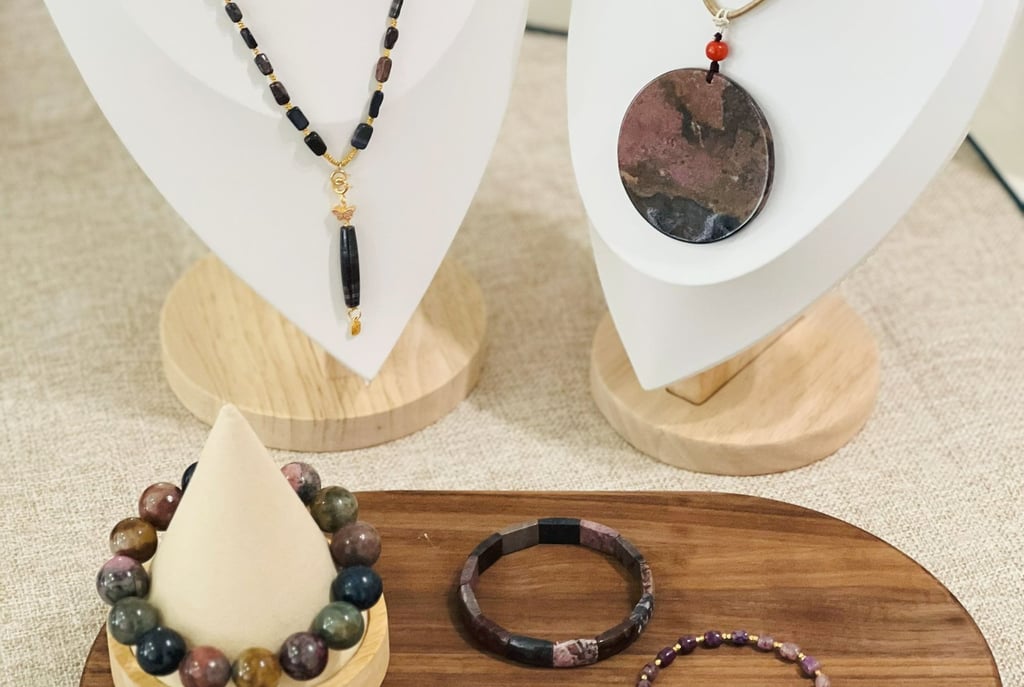The Allure of Sugilite: Mystical Properties
Sugilite is one of the lesser-known yet powerfully spiritual gemstones in the mineral world. With its striking purple hues and metaphysical allure, this rare stone has captivated collectors, healers, and gem enthusiasts since its discovery


A Brief History of Sugilite
Sugilite was first discovered in 1944 by Japanese petrologist Dr. Ken-ichi Sugi, from whom it derives its name. The original discovery occurred on Iwagi Island in Japan, though it was only available in small quantities and in a yellowish-brown form—not the vibrant purple hue it is known for today.
The true rise of sugilite began in the 1970s when gem-quality deposits were unearthed in the Kalahari manganese fields of South Africa. These new finds revealed deep purple to magenta stones with a translucent to opaque texture, quickly gaining attention in metaphysical circles and among gemstone collectors. Due to its rarity and exotic appeal, sugilite became known as a "New Age" gemstone—frequently used in meditation, healing, and energy work.
Metaphysical and Spiritual Benefits of Wearing Sugilite
Although sugilite is not a traditional birthstone or zodiac stone, its spiritual significance has grown considerably over the decades. Many believe that sugilite is one of the most powerful healing stones for emotional and spiritual wellbeing.
1. Emotional Healing and Love
Sugilite is often referred to as the "Stone of Love" and "Healer’s Stone." It's said to carry the energy of unconditional love and aid those struggling with grief, sorrow, or trauma. By opening the heart chakra and linking it with the crown chakra, sugilite facilitates deep emotional healing and encourages compassion toward oneself and others.
2. Protection from Negativity
In the metaphysical community, sugilite is highly regarded for its ability to create a protective shield around the wearer. It is thought to absorb and transmute negative energies, whether emotional, mental, or even electromagnetic (EMF) pollution. Empaths and highly sensitive individuals often use sugilite as a buffer against the chaos of the outside world.
3. Enhanced Intuition and Spiritual Growth
Sugilite resonates strongly with the crown and third-eye chakras, making it a favored tool for spiritual seekers. It’s believed to help activate psychic abilities, promote lucid dreaming, and enhance meditative states. For those on a path of enlightenment or spiritual development, sugilite can serve as a guiding force.
4. Physical Healing (Anecdotal)
While scientific evidence does not support physical healing through stones, users in the crystal healing community claim sugilite can aid issues related to the nervous system, headaches, inflammation, and insomnia. It is also said to promote overall energetic balance within the body.
How to Identify and Recognize the Value of Sugilite
Due to its growing popularity and limited availability, sugilite can be expensive. Whether you're a collector or simply want to benefit from its energies, it's essential to understand how to evaluate genuine sugilite.
1. Color
Color is the most critical factor in determining sugilite's value. The most sought-after hues are:
Deep Purple or Violet – Often referred to as "gel" sugilite, this translucent variety is the rarest and most valuable.
Royal Purple or Magenta – Opaque stones with vibrant saturation are also highly prized.
Lavender or Lilac Shades – While still beautiful, these tend to be more common and thus less valuable.
Low-quality sugilite may appear blotchy or grayish with less visual appeal.
2. Clarity and Texture
Sugilite ranges from opaque to translucent. Translucent “gel” sugilite is the most prized and commands a high price per carat. Opaque varieties are more common and are typically used in beads and cabochons. Internal veining of manganese or other minerals is typical and doesn't necessarily reduce value unless it overshadows the color.
3. Cut and Shape
Sugilite is typically cut into cabochons (rounded, polished stones) for use in jewelry. Smooth, symmetrical cabochons with intense color and minimal inclusions are more valuable. Beads and carvings made from sugilite are also popular, though they generally fetch lower prices than well-cut stones.
4. Treatment and Imitation
Some low-quality stones may be dyed or stabilized to enhance color. Additionally, imitation stones made from dyed howlite, charoite, or even plastic are sometimes sold as sugilite. Always ask for certification. A trained gemologist can test for authenticity through spectroscopy and hardness (sugilite ranks around 6–6.5 on the Mohs scale).
In conclusion
This powerful crystal often finds its way into your life when you’re ready to embrace deep healing, transformation, or inner strength. Rather than selecting it based on appearance or meaning alone, sugilite's presence is a reflection of what your soul is calling in. When you feel an unexplainable pull toward this stone, trust that it’s responding to your energy—guiding, supporting, and aligning with your journey in ways beyond conscious choice.
